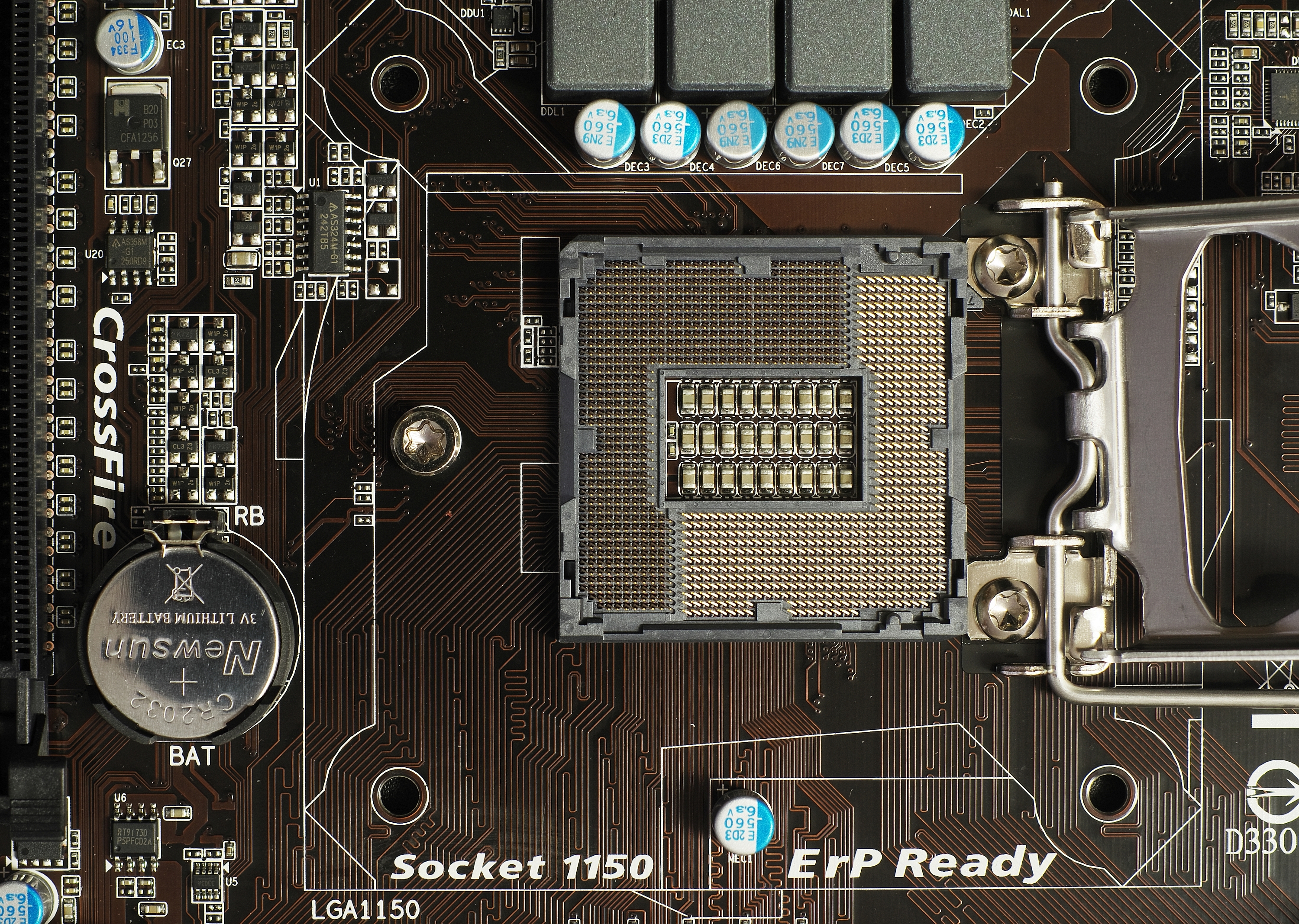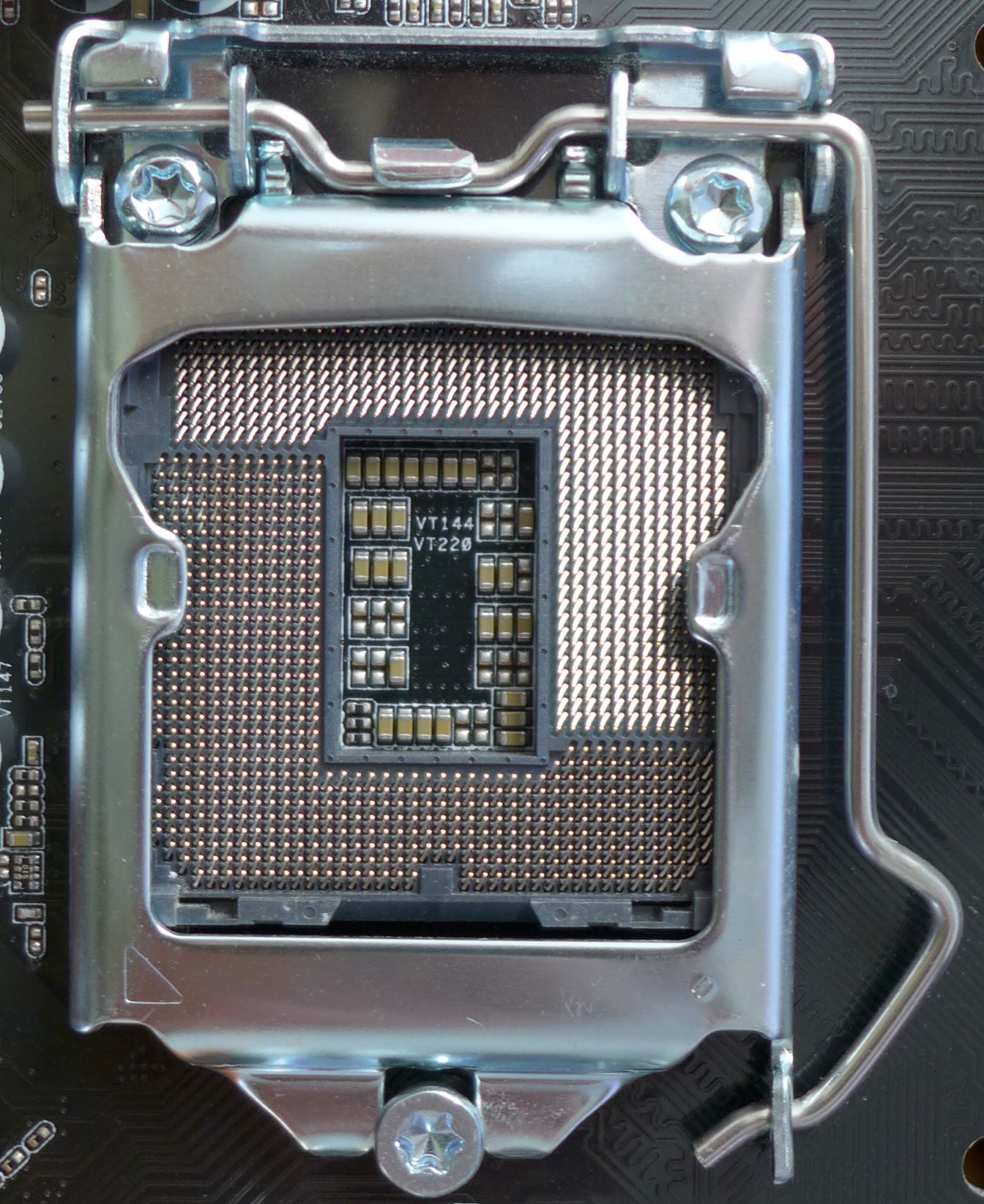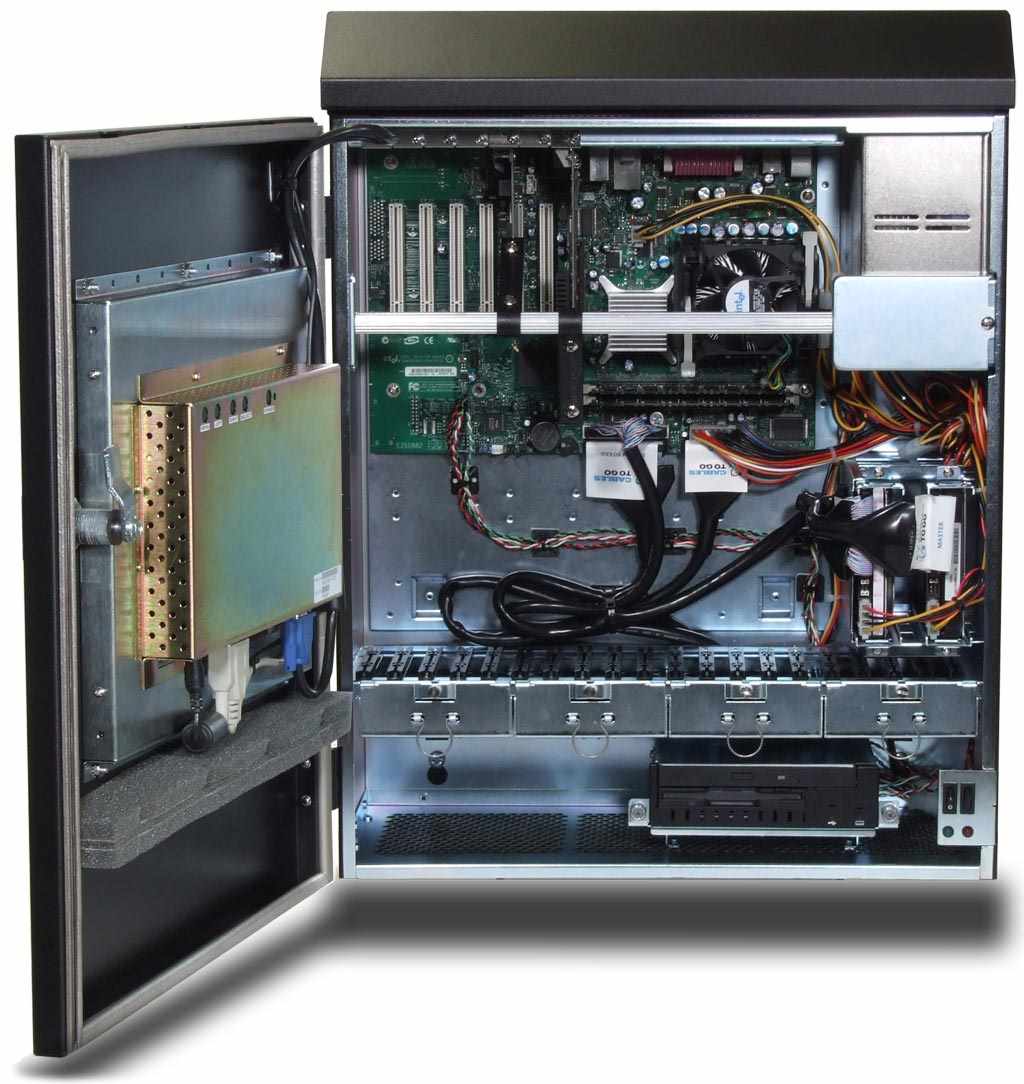|
Socket H3
LGA 1150, also known as Socket H3, is a zero insertion force flip-chip land grid array (LGA) CPU socket designed by Intel for CPUs built on the Haswell microarchitecture. This socket is also used by the Haswell's successor, Broadwell microarchitecture. It is the successor of LGA 1155 and was itself succeeded by LGA 1151 in 2015. Most motherboards with the LGA 1150 socket support varying video outputs (VGA, DVI or HDMI depending on the model) and Intel Clear Video Technology. Full support of Windows on LGA 1150 platform starts on Windows 7 - official Windows XP support is limited to selected CPUs, chipsets and only for embedded and industrial systems. Intel's Platform Controller Hub (PCH) for the LGA 1150 CPUs is codenamed Lynx Point. Intel Xeon processors for socket LGA 1150 use the Intel C222, C224, and C226 chipsets. Heatsink The 4 holes for fastening the heatsink to the motherboard are placed in a square with a lateral length of 75&nb ... [...More Info...] [...Related Items...] OR: [Wikipedia] [Google] [Baidu] |
Intel Socket 1150 IMGP8593 Smial Wp
Intel Corporation is an American multinational corporation and technology company headquartered in Santa Clara, California. It is the world's largest semiconductor chip manufacturer by revenue, and is one of the developers of the x86 series of instruction sets, the instruction sets found in most personal computers (PCs). Incorporated in Delaware, Intel ranked No. 45 in the 2020 ''Fortune'' 500 list of the largest United States corporations by total revenue for nearly a decade, from 2007 to 2016 fiscal years. Intel supplies microprocessors for computer system manufacturers such as Acer, Lenovo, HP, and Dell. Intel also manufactures motherboard chipsets, network interface controllers and integrated circuits, flash memory, Graphics processing unit, graphics chips, Embedded system, embedded processors and other devices related to communications and computing. Intel (''int''egrated and ''el''ectronics) was founded on July 18, 1968, by semiconductor pioneers Gordon Moore (of M ... [...More Info...] [...Related Items...] OR: [Wikipedia] [Google] [Baidu] |
Microarchitecture
In computer engineering, microarchitecture, also called computer organization and sometimes abbreviated as µarch or uarch, is the way a given instruction set architecture (ISA) is implemented in a particular processor. A given ISA may be implemented with different microarchitectures; implementations may vary due to different goals of a given design or due to shifts in technology. Computer architecture is the combination of microarchitecture and instruction set architecture. Relation to instruction set architecture The ISA is roughly the same as the programming model of a processor as seen by an assembly language programmer or compiler writer. The ISA includes the instructions, execution model, processor registers, address and data formats among other things. The microarchitecture includes the constituent parts of the processor and how these interconnect and interoperate to implement the ISA. The microarchitecture of a machine is usually represented as (more or less detai ... [...More Info...] [...Related Items...] OR: [Wikipedia] [Google] [Baidu] |
LGA 1151
LGA 1151, also known as Socket H4, is a type of zero insertion force flip-chip land grid array (LGA) socket for Intel desktop processors which comes in two distinct versions: the first revision which supports both Intel's Skylake and Kaby Lake CPUs, and the second revision which supports Coffee Lake CPUs exclusively. LGA 1151 is designed as a replacement for the LGA 1150 (known as ''Socket H3''). LGA 1151 has 1151 protruding pins to make contact with the pads on the processor. The Fully Integrated Voltage Regulator, i.e. a voltage regulator which integrated on the CPU's die, introduced with Haswell and Broadwell, has again been moved to the motherboard. Most motherboards for the first revision of the socket support solely DDR4 memory, a lesser number support DDR3(L) memory, and the least number have slots for both DDR4 or DDR3(L) but only one memory type can be installed. Some have UniDIMM support, enabling either type of memory to be placed in the same DIMM, rather than ... [...More Info...] [...Related Items...] OR: [Wikipedia] [Google] [Baidu] |
LGA 1156
LGA 1156 (land grid array 1156), also known as Socket H or H1, is an Intel desktop CPU socket. Its incompatible successor is LGA 1155. The last processors supporting it ceased production in 2011. LGA 1156, along with LGA 1366, were designed to replace LGA 775. Whereas LGA 775 processors connect to a northbridge using the Front Side Bus, LGA 1156 processors integrate the features traditionally located on a northbridge within the processor itself. The LGA 1156 socket allows the following connections to be made from the processor to the rest of the system: * PCI-Express 2.0 ×16 for communication with a graphics card. Some processors allow this connection to be divided into two ×8 lanes to connect two graphics cards. Some motherboard manufacturers use Nvidia's NF200 chip to allow even more graphics cards to be used. * DMI for communication with the Platform Controller Hub (PCH). This consists of a PCI-Express 2.0 ×4 connection. * FDI for communication with the PCH. Thi ... [...More Info...] [...Related Items...] OR: [Wikipedia] [Google] [Baidu] |
Chipset
In a computer system, a chipset is a set of electronic components An electronic component is any basic discrete device or physical entity in an electronic system used to affect electrons or their associated fields. Electronic components are mostly industrial products, available in a singular form and are no ... in one or more integrated circuits known as a "Data Flow Management System" that manages the data flow between the Central processing unit, processor, computer memory, memory and peripherals. It is usually found on the motherboard. Chipsets are usually designed to work with a specific family of microprocessors. Because it controls communications between the processor and external devices, the chipset plays a crucial role in determining Computer performance, system performance. Computers In computing, the term ''chipset'' commonly refers to a set of specialized integrated circuit, chips on a computer's motherboard or an expansion card. In personal computers, the first ... [...More Info...] [...Related Items...] OR: [Wikipedia] [Google] [Baidu] |
Intel Xeon Chipsets
Around the time that the Pentium III processor was introduced, Intel's Xeon line diverged from its line of desktop processors, which at the time was using the Pentium branding. The divergence was implemented by using different sockets; since then, the sockets for Xeon chips have tended to remain constant across several generations of implementation. The chipsets contain a 'memory controller hub' and an 'I/O controller hub', which tend to be called 'north bridge' and 'south bridge' respectively. The memory controller hub connects to the processors, memory, high-speed I/O such as PCI Express, and to the I/O controller hub by a proprietary link. The I/O controller hub, on the other hand, connects to lower-speed I/O, such as SATA, PCI, USB, and Ethernet. P6-based Xeon chipsets Dual processor P6-based Xeon chipsets Intel's initial preferred chipset for Pentium III Xeon was the 840. Four processor P6-based Xeon chipsets The Pentium III Xeon bus protocol allowed four proces ... [...More Info...] [...Related Items...] OR: [Wikipedia] [Google] [Baidu] |
Xeon
Xeon ( ) is a brand of x86 microprocessors designed, manufactured, and marketed by Intel, targeted at the non-consumer workstation, server, and embedded system markets. It was introduced in June 1998. Xeon processors are based on the same architecture as regular desktop-grade CPUs, but have advanced features such as support for ECC memory, higher core counts, more PCI Express lanes, support for larger amounts of RAM, larger cache memory and extra provision for enterprise-grade reliability, availability and serviceability (RAS) features responsible for handling hardware exceptions through the Machine Check Architecture. They are often capable of safely continuing execution where a normal processor cannot due to these extra RAS features, depending on the type and severity of the machine-check exception (MCE). Some also support multi-socket systems with two, four, or eight sockets through use of the Ultra Path Interconnect (UPI) bus. Overview The ''Xeon'' brand has been mainta ... [...More Info...] [...Related Items...] OR: [Wikipedia] [Google] [Baidu] |
Lynx Point
The Platform Controller Hub (PCH) is a family of Intel's single-chip chipsets, first introduced in 2009. It is the successor to the Intel Hub Architecture, which used two chips - a northbridge and southbridge, and first appeared in the Intel 5 Series. The PCH controls certain data paths and support functions used in conjunction with Intel CPUs. These include clocking (the system clock), Flexible Display Interface (FDI) and Direct Media Interface (DMI), although FDI is used only when the chipset is required to support a processor with integrated graphics. As such, I/O functions are reassigned between this new central hub and the CPU compared to the previous architecture: some northbridge functions, the memory controller and PCIe lanes, were integrated into the CPU while the PCH took over the remaining functions in addition to the traditional roles of the southbridge. AMD has its equivalent for the PCH, known simply as a chipset, no longer using the previous term Fusion control ... [...More Info...] [...Related Items...] OR: [Wikipedia] [Google] [Baidu] |
Platform Controller Hub
The Platform Controller Hub (PCH) is a family of Intel's single-chip chipsets, first introduced in 2009. It is the successor to the Intel Hub Architecture, which used two chips - a Northbridge (computing), northbridge and Southbridge (computing), southbridge, and first appeared in the Intel 5 Series. The PCH controls certain data paths and support functions used in conjunction with Intel CPUs. These include clocking (the system clock), Flexible Display Interface (FDI) and Direct Media Interface (DMI), although FDI is used only when the chipset is required to support a processor with integrated graphics. As such, I/O functions are reassigned between this new central hub and the CPU compared to the previous architecture: some northbridge functions, the memory controller and PCI Express, PCIe lanes, were integrated into the CPU while the PCH took over the remaining functions in addition to the traditional roles of the southbridge. AMD has its equivalent for the PCH, known simply as a ... [...More Info...] [...Related Items...] OR: [Wikipedia] [Google] [Baidu] |
Industrial PC
An industrial PC is a computer intended for industrial purposes (production of goods and services), with a form factor between a nettop and a server rack. Industrial PCs have higher dependability and precision standards, and are generally more expensive than consumer electronics. They often use complex instruction sets, such as x86, where reduced instruction sets such as ARM would otherwise be used. History IBM released the 5531 Industrial Computer in 1984, arguably the first "industrial PC". The IBM 7531, an industrial version of the IBM AT PC was released May 21, 1985. Industrial Computer Source first offered the 6531 Industrial Computer in 1985. This was a proprietary 4U rackmount industrial computer based on a clone IBM PC motherboard. Applications Industrial PCs are primarily used for process control and/or data acquisition. In some cases, an industrial PC is simply used as a front-end to another control computer in a distributed processing environment. Software ... [...More Info...] [...Related Items...] OR: [Wikipedia] [Google] [Baidu] |
Embedded System
An embedded system is a computer system—a combination of a computer processor, computer memory, and input/output peripheral devices—that has a dedicated function within a larger mechanical or electronic system. It is ''embedded'' as part of a complete device often including electrical or electronic hardware and mechanical parts. Because an embedded system typically controls physical operations of the machine that it is embedded within, it often has real-time computing constraints. Embedded systems control many devices in common use today. , it was estimated that ninety-eight percent of all microprocessors manufactured were used in embedded systems. Modern embedded systems are often based on microcontrollers (i.e. microprocessors with integrated memory and peripheral interfaces), but ordinary microprocessors (using external chips for memory and peripheral interface circuits) are also common, especially in more complex systems. In either case, the processor(s) used ... [...More Info...] [...Related Items...] OR: [Wikipedia] [Google] [Baidu] |
Windows XP
Windows XP is a major release of Microsoft's Windows NT operating system. It was released to manufacturing on August 24, 2001, and later to retail on October 25, 2001. It is a direct upgrade to its predecessors, Windows 2000 for high-end and business users and Windows Me for home users, available for any devices running Windows NT 4.0, Windows 98, Windows 2000 and Windows Me that meet the new Windows XP system requirements. Development of Windows XP began in the late 1990s under the codename "Neptune", built on the Windows NT kernel explicitly intended for mainstream consumer use. An updated version of Windows 2000 was also initially planned for the business market. However, in January 2000, both projects were scrapped in favor of a single OS codenamed "Whistler", which would serve as a single platform for both consumer and business markets. As a result, Windows XP is the first consumer edition of Windows not based on the Windows 95 kernel and MS-DOS. Windows XP removed suppo ... [...More Info...] [...Related Items...] OR: [Wikipedia] [Google] [Baidu] |







